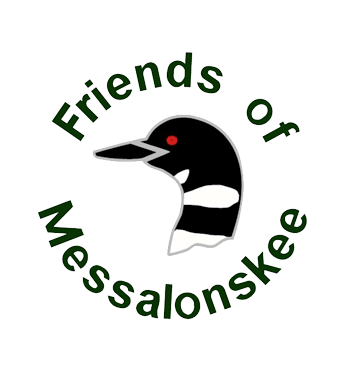WATER QUALITY
Messalonskee Water Quality Update
Dr. Danielle Wain, Lake Science Director, 7 Lakes Alliance
Lynn Geiger, Erosion Control Policy Manager, 7 Lakes Alliance
Data from the 7 Lakes Alliance – Colby Water Quality Initiative
Average water clarity on Messalonskee (measured by Secchi Disk Transparency) averaged 15 ft this year, which is the worst it has been since the intensive monitoring of the 7 Lakes-Colby Water Quality Initiative began in 2015 (Figure 1). This is 3 ft worse than 2022 and just 2 ft shy of crossing the poor water quality threshold (indicated by the red dashed line). This decline in water clarity is almost certainly due to the rainy summer we had in the Belgrades. Messalonskee, like Great Pond and Long Pond, appears to be very sensitive to the amount of rainfall we receive in a given year. More rain creates more erosion, which washes more sediment and phosphorus into the lake, which both reduce water clarity.
From 2021-2023, the 7 Lakes Alliance and Friends of Messalonskee (FOM) volunteers conducted stream sampling across the Messalonskee Lake watershed to measure phosphorus entering the lake through streams. In total, 17 sites around the lake were sampled, in addition to 10 sites on Belgrade Stream. From the recently completed Messalonskee Lake Watershed Protection Plan, we can identify areas of the watershed that might be prone to erosion and high contribution of phosphorus to the lake. In Figure 2, we present the average phosphorus from all the sampling combined with the identified erosion sites from the protection plan. In this graph, the circles represent the locations where these measurements were taken. The size of the circles reflects the number of samples at that location (smaller for fewer samples and larger for more). The darker colors of the circles indicate higher levels of phosphorus found at that site. The watershed areas that contribute to specific streams are shaded in different colors. Finally, the location and severity of all the Non-Point Sources of phosphorus (runoff from roads and lawns) identified in the Watershed Survey are marked by triangles, with red triangles indicating the worst sites for erosion issues. Hot spots with high concentrations of phosphorus are scattered around the lake, typically at sites where there is significant upstream development. Sanford Brook, which enters Belgrade Stream, was also a hot spot for phosphorus entering from the watershed.
The reduction in water clarity during this rainy year has emphasized the importance of addressing the watershed sources of phosphorus entering the lake. Contact FOM for a LakeSmart evaluation to ensure your property is not contributing to the problem!
Many thanks to Danielle and Lynn for this sobering article. The results underscore the importance of all three Watershed Projects; Road Construction, YCC, and LakeSmart. We will make this map available on the website so it can be enlarged.

Figure 1: Yearly average Secchi disk transparency for 2015-2023. Above the red dashed line is poor water quality conditions; below the green dashed line indicates good water quality.

Figure 2: Stream sampling sites, phosphorus levels, and potential erosions sites identified by the watershed survey (created by Lynn Geiger, 7LA).

